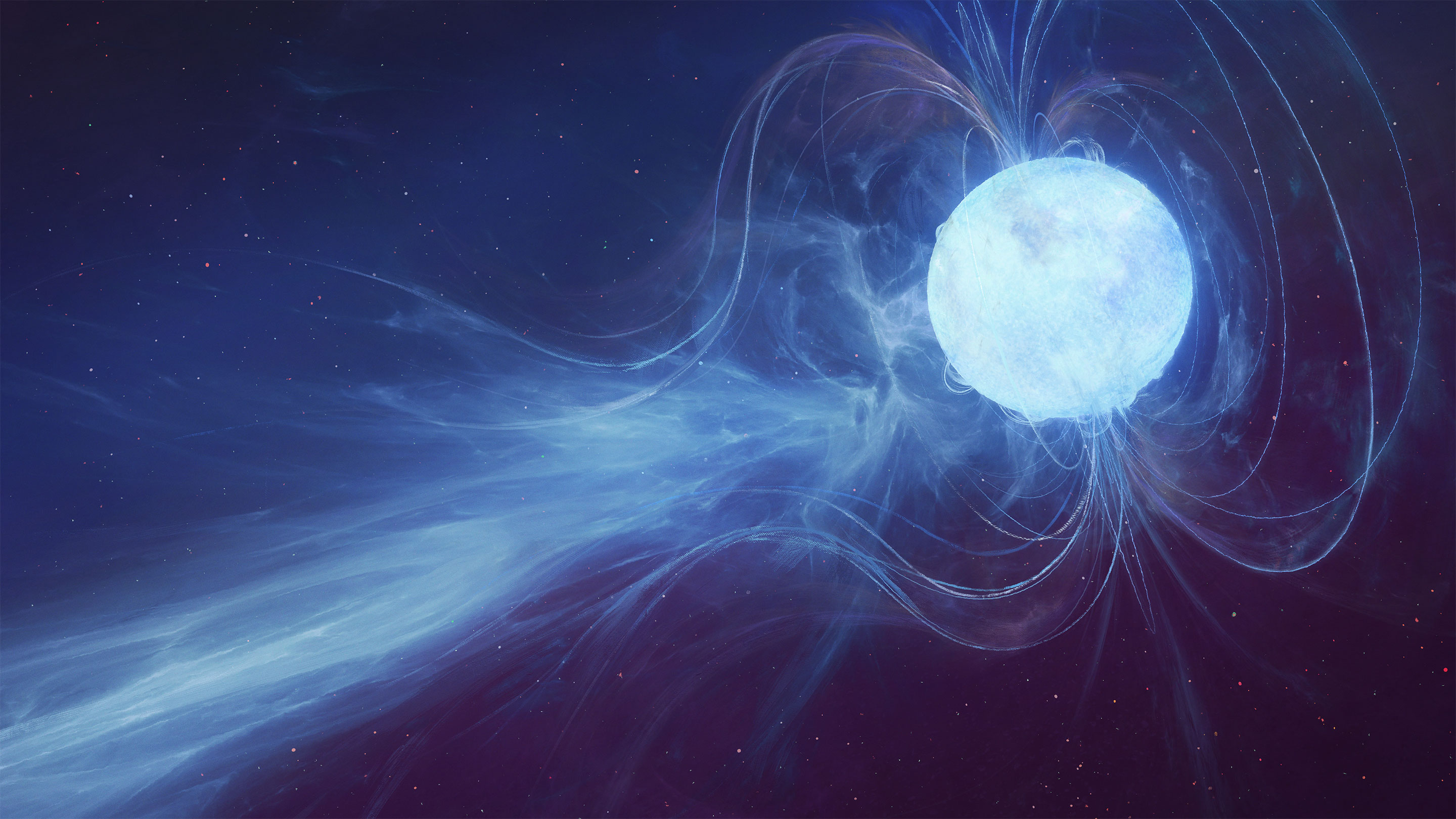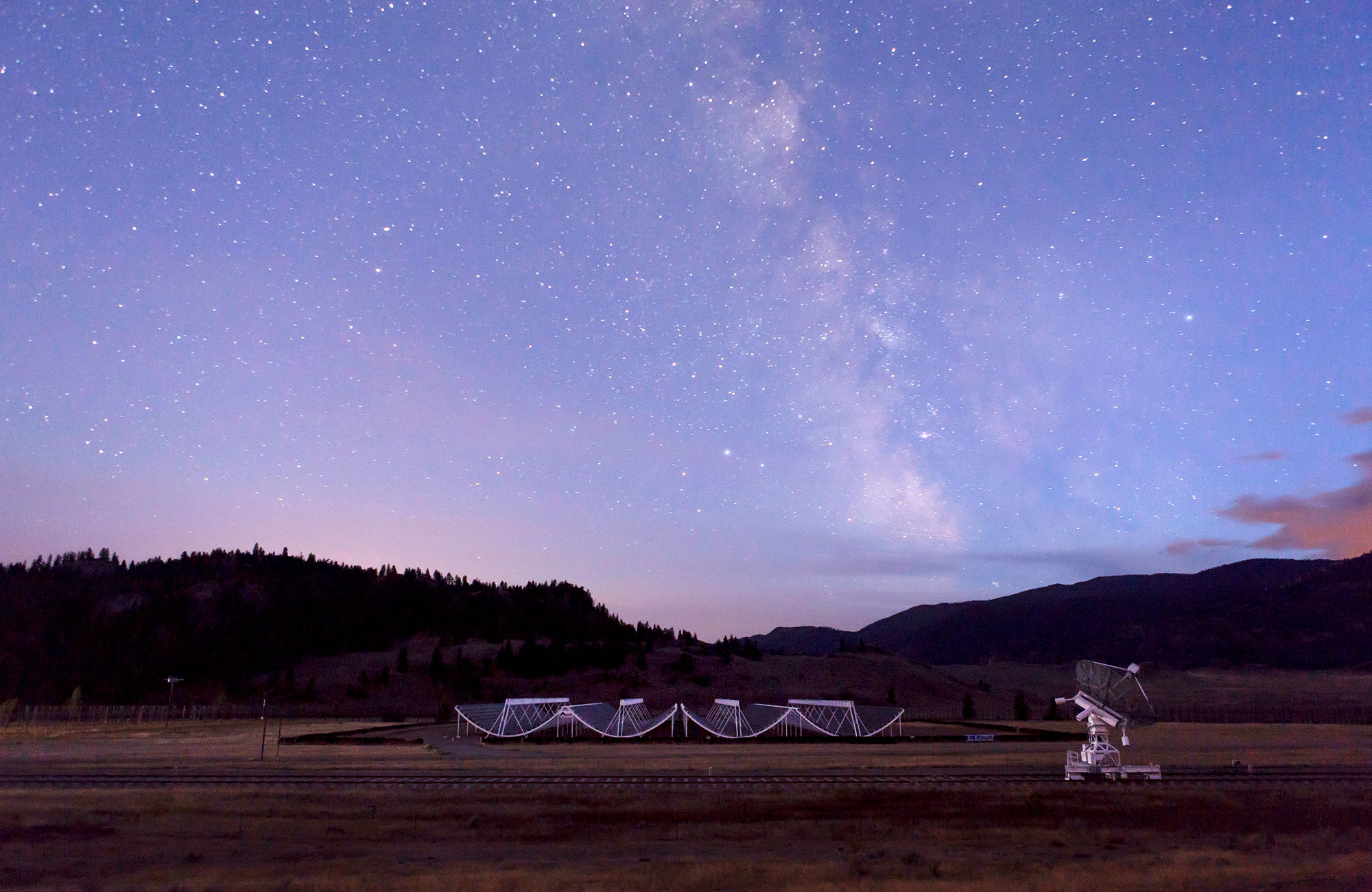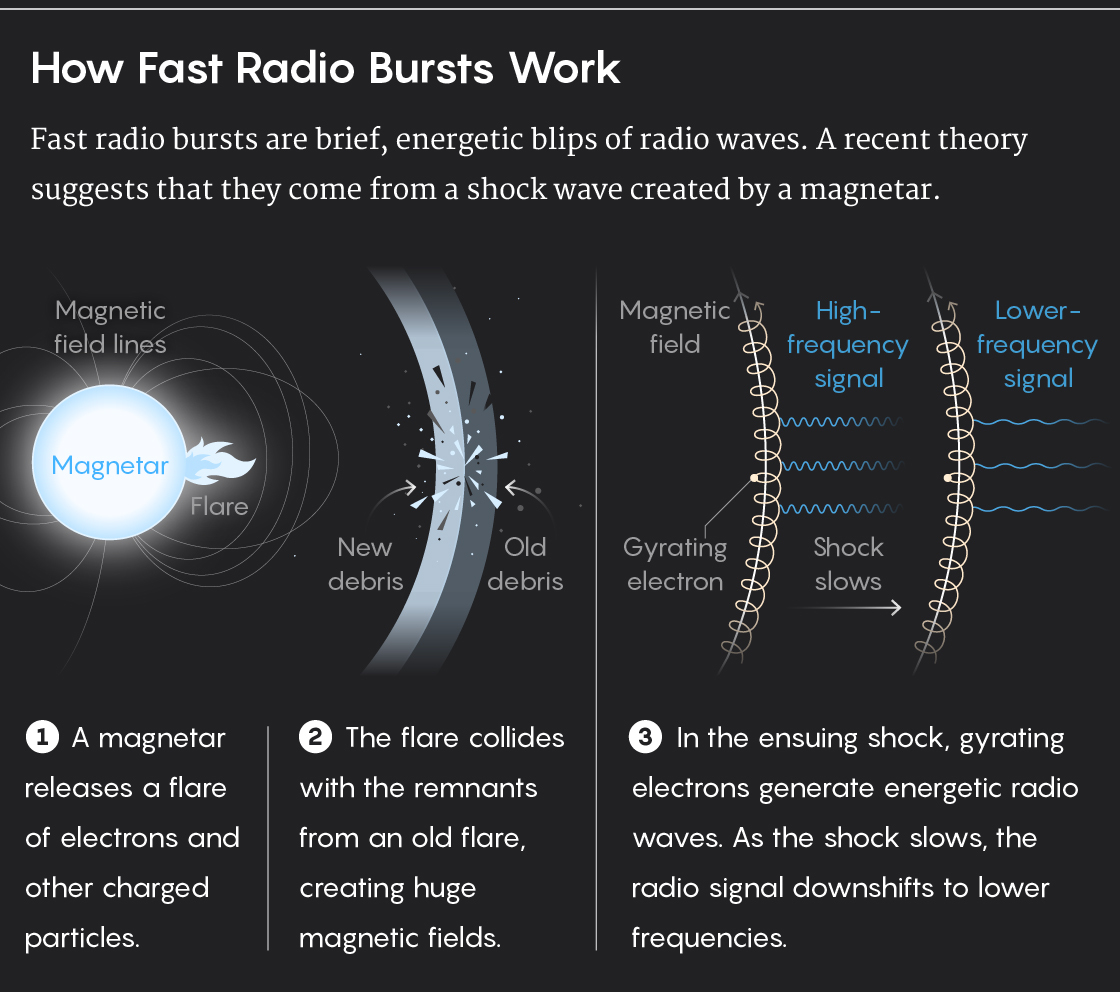A Surprise Discovery Points to the Source of Fast Radio Bursts

The fast radio burst was tracked back to a magnetar — an extremely dense stellar fossil that generates tremendous magnetic fields.
Maciej Rebisz for Quanta Magazine
Introduction
On the morning of April 28, a newly built radio telescope was monitoring the quiet skies over British Columbia when it caught the flash that would change everything. One of the telescope’s duties was to search for fast radio bursts — millisecond-long blips that, until then, had always come from distant galaxies. No one knew for sure what could create such short explosions of radio waves, making fast radio bursts one of the most intriguing puzzles in astrophysics.
The Canadian Hydrogen Intensity Mapping Experiment, or CHIME, had already spotted hundreds of fast radio bursts since it came online in July 2018. An ordinary burst might be seen by two to five of the instrument’s antennas. This burst triggered 93. “It lit up our telescope like a Christmas tree,” said Paul Scholz, an astronomer at the University of Toronto and a member of the CHIME team.
Scholz and his colleagues quickly realized that the burst must be nearby, and not just because the flash was so bright. The flare appeared to originate from a part of the sky where an object in the Milky Way had been shooting out X-rays. The coincidence was strong, and if confirmed, it would let astronomers figure out what causes fast radio bursts.
There was a problem, though. The burst was far from the part of the sky that CHIME was directly monitoring at the time. Because of that, the team couldn’t get a precise read on its absolute brightness. Without that information, they couldn’t immediately tell if the burst was powerful enough to qualify as a true fast radio burst. Sure, it was brief and bright — but its brightness was to be expected since it was so close by. It could just be an ordinary low-energy burp, offering no clues about the major eruptions.
Scholz immediately filed a message with The Astronomer’s Telegram to alert other telescopes around the world. Astronomers based at the California Institute of Technology saw the alert and performed a quick scan of their own data. Unlike CHIME, which looks at small chunks of the sky at any given time, Caltech’s Survey for Transient Astronomical Radio Emission 2 (STARE2) telescope observes the entire sky at once, which allowed the Caltech team to quickly confirm that the burst was extremely powerful. For a brief fraction of a second, the radio waves put out by the source were as bright as those from the sun. That allowed researchers to do a quick back-of-the-envelope calculation and affirm that the burst was comparable to extragalactic fast radio bursts.

The CHIME radio telescope operates in remote British Columbia, far from civilization’s incessant electronic thrum.
Peter Klages
The astronomers then turned toward the previously known source: an ultra-dense, rapidly spinning and highly magnetized cinder of a stellar core called a magnetar. With a single lucky discovery, the mystery of where fast radio bursts come from appeared to have been solved. “It’s not so often that you get a clue that is so striking that it seems to suddenly solve a big chunk of the puzzle,” said Jason Hessels of the Netherlands Institute for Radio Astronomy and the University of Amsterdam. “Normally we’re kind of chipping away at the problem as opposed to making such a giant leap forward.”
With the culprit in hand, astronomers can now focus on pinpointing the nitty-gritty physics at play. Over the past month, a flood of papers has appeared as theorists have speculated how magnetars might launch such brilliant flashes of radio waves. It’s likely that the magnetar starts the process by blasting charged particles in a powerful flare. But astrophysicists are debating exactly how that flare produces the burst of radio waves. It’s similar to identifying a magician, Hessels said, and then trying to decipher the secrets behind their trick.
How a Burst Bursts
Astronomers have racked up roughly 50 separate theories to explain fast radio bursts — a tally that until recently outnumbered the events. The ideas include a variety of wild scenarios involving evaporating black holes, snapping cosmic strings, and even the propulsion systems of alien civilizations.
But as the number of detections increased, scientists began to favor one explanation above the rest: magnetars. “There were just a number of their properties that really screamed out that they were coming from some kind of magnetized neutron star,” said Brian Metzger, an astrophysicist at Columbia University. For example, a fast radio burst’s waves are highly polarized, which suggests that they come from an intense magnetic field. Their short duration implies that they come from a relatively small astrophysical object. And they must be powered by a substantial reservoir of energy.
Skeptics, however, have argued that if magnetars were the source, we should see fast radio bursts within our own galaxy. With this burst, we have. “In some ways, it’s a great relief,” said Metzger, who has worked on magnetar models. “It means I haven’t thrown away several years of work.”
The task now is to pinpoint exactly how a magnetar creates the brief burst of radio waves. Many ideas begin with a magnetar blasting out a flare of energy, often in the form of electron and positron pairs. These flares can then produce radio waves via one of two broad mechanisms — one that occurs within the magnetosphere (the intense magnetic field that surrounds the magnetar) and one that occurs well beyond. In the first scenario, the flare of energy remains anchored to the crust of the star via magnetic field lines. As the crust continuously jostles about, these magnetic fields twist and turn until they snap to a simpler state, immediately releasing a laserlike flash of radio waves.
In the second scenario, which Metzger and his colleagues published last year, the flare of energy escapes the magnetosphere and travels a large distance — up to 1 million times the radius of the magnetar. Here it plows into the older debris surrounding the magnetar and generates a shock wave. That shock moves outward, compressing the magnetized plasma ahead of it and building a magnetic field behind it. Then, as electrons are swept up by the shock front, they begin to gyrate around the magnetic field — a dance that emits another laserlike flash of radio waves. This model makes a crucial prediction. The same shock that generates the radio emission should also heat the electrons, causing them to emit X-rays. In fact, the burst should release 100,000 times more energy in X-rays than in radio waves.

Lucy Reading-Ikkanda/Quanta Magazine
But when the only fast radio bursts have come from distant galaxies, it’s impossible to check this prediction. The simple reason? X-ray telescopes aren’t as sensitive as radio telescopes. Even all that X-ray energy would still be invisible to us.
Not so when the burst is in our cosmic backyard. A full X-ray analysis of this new burst found that it released a colossal amount of X-ray radiation — perfectly matching Metzger’s prediction. “I’m amazed how well the model works,” Metzger said. “It gives you a little kick and says, ‘Maybe this is worth my time.’”
The Magnetar Attraction
While a single event can’t prove that all fast radio bursts come from magnetars, Vikram Ravi, an astronomer at Caltech, doesn’t see any reason to invoke other objects to explain the variety of possible burst behavior. And given the amount of evidence that pointed to magnetars even before this discovery, Metzger notes that it’s plausible to assume that different types of magnetars can explain the many types of fast radio bursts we see. For example, fast radio bursts that repeat could come from young, active magnetars whose magnetic fields are much stronger than the ones in our galaxy.
The link means that we can use fast radio bursts to identify magnetars in the distant universe, allowing scientists to build a census of these extreme objects and better explain their origins. In our galaxy, we suspect that magnetars form in brilliant supernova explosions. But if we begin to see them in galaxies without massive stars, that might point toward more exotic ways to create a magnetar, such as the collision of two neutron stars.
But first, scientists will keep an eye on nearby magnetars in the hope of seeing another shockingly close burst. Though the magnetar connection wasn’t a total surprise, they’d like to see it confirmed by many more examples. “It still comes as a shock in the sense of ‘oh my God, it’s really true,’” Hessels said. “There’s a huge difference between some equations on a piece of paper and then being confronted that it’s actually real, that we just proved it.”
This article was reprinted on Wired.com.



